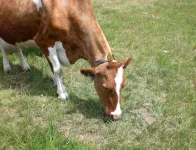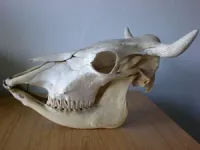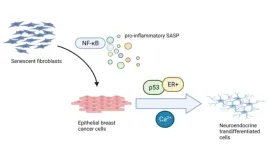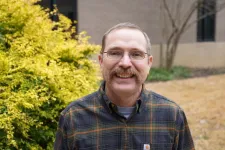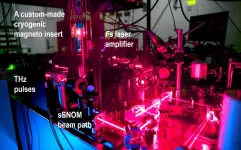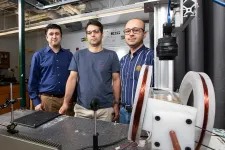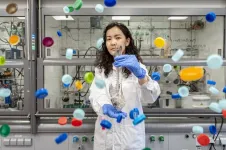(Press-News.org) Ruminants like cows have developed an unusual way of digesting their food: they ingest plants, give them a rough chewing and then swallow the half-chewed mash before regurgitating it repeatedly and continuing to chew. This has clear advantages, as a research team including the University of Göttingen has shown: the regurgitated mushy food contains much less hard grit, sand and dust than the food that they first ingested. This protects the teeth from being ground down during the chewing process. This may explain why the crowns of the teeth of ruminants are less pronounced than those of other herbivores. The findings have been published in the journal Proceedings of the National Academy of Science (PNAS).
The researchers fed four cows grass feed mixed with sand for several days and took samples of the regurgitated food pulp and faeces. They then measured the silicate content of each sample. The compounds from sand and grass are particularly abrasive to teeth because of their hardness. The faeces contained about the same amount of silicates as the grass feed mixed with sand, whereas the regurgitated food contained significantly less. The only explanation is that the silicates must have stayed in the stomach, or more precisely in the “rumen”. The rumen is the largest stomach compartment in ruminants and the place where food is fermented and broken down by microorganisms.
Because this laborious chewing is partly carried out on food pulp that has been "washed" in the rumen, the teeth of ruminants are less worn than those of horses, for example. The latter chew their food completely after ingestion, including the abrasive bits. For the researchers, this observation makes sense because the teeth of ruminants have comparatively low crowns. The method of digestion means the teeth remain functional for longer. It explains the distinctive shape of ruminant’s teeth: there has been no evolutionary pressure to form more tooth material.
"Our research explains a fundamental but little-studied aspect of food grinding in large herbivores, which contributes to the understanding of the function and evolution of teeth," explains Professor Jürgen Hummel, the University of Göttingen’s Ruminant Nutrition Group. In addition to understanding the physiology of digestion, the result is interesting for palaeontology: teeth are well preserved as fossils and often provide the most important clues in reconstructing early herbivores and their environment.
Original publication: Valerio et al. (2022): The Ruminant sorting mechanism protects teeth from abrasives. PNAS 2022, DOI: 10.1073/pnas.2212447119
A commentary in PNAS refers to the results and discusses the topic further: Sanson GD (2023): Reassessing assumptions about the evolution of herbivore teeth. PNAS 2023, DOI: 10.1073/pnas.2219060120
Contact:
Professor Jürgen Hummel
University of Göttingen
Ruminant Nutrition Group
Kellnerweg 6, 37077 Göttingen, Germany
Tel: +49 (0551) 39-23359
Email: jhummel@gwdg.de
www.uni-goettingen.de/de/492912.html
END
Healthy teeth thanks to the "washing machine effect”
Research team including Göttingen University explains tooth abrasion in cows
2023-05-12
ELSE PRESS RELEASES FROM THIS DATE:
The senescence-associated secretory phenotype induces neuroendocrine transdifferentiation
2023-05-12
“We recently unveiled a new interesting role for SASP: its ability to induce neuroendocrine transdifferentiation (NED) in breast cancer epithelial cells [3].”
BUFFALO, NY- May 12, 2023 – A new editorial paper was published in Aging (listed by MEDLINE/PubMed as "Aging (Albany NY)" and "Aging-US" by Web of Science) Volume 15, Issue 8, entitled, “The senescence-associated secretory phenotype induces neuroendocrine transdifferentiation.”
In this editorial, researchers Anda Huna, Nadine Martin and David Bernard from the Université de Lyon discuss the senescence-associated secretory phenotype (SASP). SASP, ...
Steckel selected as a Southern Weed Science Society Fellow
2023-05-12
Larry Steckel, row crop weed specialist and professor in the Department of Plant Sciences at the University of Tennessee Institute of Agriculture, has been named a Fellow of the Southern Weed Science Society (SWSS).
The award was given to honor Steckel’s years of research and contributions to weed prevention in row crop agriculture. Steckel was among only a small group of esteemed researchers to receive the honor, presented to him during the annual meeting of the SWSS.
Steckel says he is proud to be named a Fellow, and that he knows the research and extension work conducted by weed specialists across the ...
Manufacturing and metrology considerations are key when designing with freeform optics
2023-05-12
Manufacturing and metrology considerations are key when designing with freeform optics
Close communication between optics designers and manufacturers can help prevent problems
Québec City, Canada -- Although optical components such as lenses are traditionally spherical in shape, freeform optical components, which have little to no symmetry around the optical axis, are becoming more common. Freeform optical components are attractive because they can be designed to behave in ways traditional optics cannot, offering optical design flexibility ...
Ultralow temperature terahertz microscope capabilities enable better quantum technology
2023-05-12
A team of scientists from the Department of Energy’s Ames National Laboratory have developed a way to collect terahertz imaging data on materials under extreme magnetic and cryogenic conditions. They accomplished their work with a new scanning probe microscope. This microscope was recently developed at Ames Lab. The team used the ultralow temperature terahertz microscope to take measurements on superconductors and topological semimetals. These materials were were exposed to high magnetic fields and temperatures below liquid helium (below 4.2 ...
New study puts a definitive age on Saturn’s rings—they’re really young
2023-05-12
A new study led by physicist Sascha Kempf at the University of Colorado Boulder has delivered the strongest evidence yet that Saturn’s rings are remarkably young—potentially answering a question that has boggled scientists for well over a century.
The research, to be published May 12 in the journal Science Advances, pegs the age of Saturn’s rings at no more than 400 million years old. That makes the rings much younger than Saturn itself, which is about 4.5 billion years old.
“In ...
Researchers identify a brain marker indicating future suicide risk
2023-05-12
FOR IMMEDIATE RELEASE, May 12, 2023
Contact: Gina DiGravio, 617-358-7838, ginad@bu.edu
Researchers Identify a Brain Marker Indicating Future Suicide Risk
Changing the connectivity in this brain circuit with stimulation or pharmacotherapies could represent new treatments to reduce suicide risk.
(Boston)—Identifying people at high risk for suicide is critical for applying lifesaving interventions and treatments. However, it is very difficult to identify who is at greatest risk and only modest improvements has been made in identifying high risk people over the last 50 years. One novel way to identify people at high risk of suicide is by investigating and identifying brain markers.
VA ...
Researchers use 3D models to investigate bacteria movement
2023-05-12
The spiral-shaped bacteria Helicobacter pylori are common and troublesome.
More than 13 percent of Americans have an H. pylori infection, although rates vary with age, race and socioeconomic status. The microorganism uses its corkscrew-like tail to power forward through viscous fluids such as stomach mucus. When it arrives at the epithelium of the stomach wall, it can cause everything from ulcers to cancer.
In a new study published by Physical Review Letters, FAMU-FSU College of Engineering researchers created a 3D model of this bacteria to better understand its movement, hoping to crack the code governing the organism’s motility ...
Researchers at Purdue discover superconductive images are actually 3D and disorder-driven fractals
2023-05-12
Meeting the world’s energy demands is reaching a critical point. Powering the technological age has caused issues globally. It is increasingly important to create superconductors that can operate at ambient pressure and temperature. This would go a long way toward solving the energy crisis.
Advancements with superconductivity hinge on advances in quantum materials. When electrons inside of quantum materials undergo a phase transition, the electrons can form intricate patterns, such as fractals. A fractal is a never-ending pattern. When zooming in on a fractal, the image looks the same. Commonly seen fractals can be a tree or frost on a windowpane ...
Save the phages to protect Big Blue
2023-05-12
The plastic era has begun, and for sure, it will last for decades or even longer. Polymer-based materials are almost everywhere, reaching even the deepest regions of the oceans, and their global production is larger than recycling, leading to the generation of tremendous amounts of water pollution with microplastics. These tiny polymer particles not only release chemicals but also reduce the number of bacteriophages. Recently, researchers from the Institute of Physical Chemistry, Polish Academy of Sciences, led by Prof. Jan Paczesny, explored ...
Head and neck cancer organoids as a step towards personalized treatments
2023-05-12
Researchers from the Organoid group (Hubrecht Institute) and UMC Utrecht have developed a biobank with organoids derived from patients with head and neck cancer (HNC). They used this biobank to validate known HNC biomarkers and found that treatment responses in the organoids matched those seen in patients. The results of the study will be published in Med on 12 May 2023 and could aid treatment decisions and discovery of novel therapies for HCN patients in the future.
Head and neck cancer (HNC) is an overarching term used for several types of cancer, including the most ...
LAST 30 PRESS RELEASES:
Injectable breast ‘implant’ offers alternative to traditional surgeries
Neuroscientists devise formulas to measure multilingualism
New prostate cancer trial seeks to reduce toxicity without sacrificing efficacy
Geometry shapes life
A CRISPR screen reveals many previously unrecognized genes required for brain development and a new neurodevelopmental disorder
Hot flush treatment has anti-breast cancer activity, study finds
Securing AI systems against growing cybersecurity threats
Longest observation of an active solar region
Why nail-biting, procrastination and other self-sabotaging behaviors are rooted in survival instincts
Regional variations in mechanical properties of porcine leptomeninges
Artificial empathy in therapy and healthcare: advancements in interpersonal interaction technologies
Why some brains switch gears more efficiently than others
UVA’s Jundong Li wins ICDM’S 2025 Tao Li Award for data mining, machine learning
UVA’s low-power, high-performance computer power player Mircea Stan earns National Academy of Inventors fellowship
Not playing by the rules: USU researcher explores filamentous algae dynamics in rivers
Do our body clocks influence our risk of dementia?
Anthropologists offer new evidence of bipedalism in long-debated fossil discovery
Safer receipt paper from wood
Dosage-sensitive genes suggest no whole-genome duplications in ancestral angiosperm
First ancient human herpesvirus genomes document their deep history with humans
Why Some Bacteria Survive Antibiotics and How to Stop Them - New study reveals that bacteria can survive antibiotic treatment through two fundamentally different “shutdown modes”
UCLA study links scar healing to dangerous placenta condition
CHANGE-seq-BE finds off-target changes in the genome from base editors
The Journal of Nuclear Medicine Ahead-of-Print Tip Sheet: January 2, 2026
Delayed or absent first dose of measles, mumps, and rubella vaccination
Trends in US preterm birth rates by household income and race and ethnicity
Study identifies potential biomarker linked to progression and brain inflammation in multiple sclerosis
Many mothers in Norway do not show up for postnatal check-ups
Researchers want to find out why quick clay is so unstable
Superradiant spins show teamwork at the quantum scale
[Press-News.org] Healthy teeth thanks to the "washing machine effect”Research team including Göttingen University explains tooth abrasion in cows
